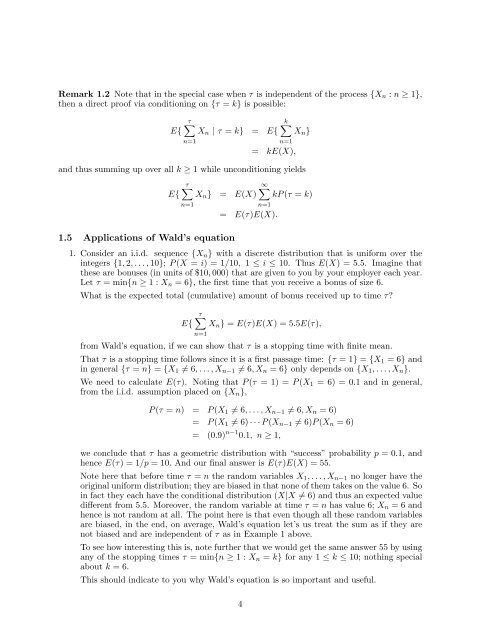stochastic-I-ST
Create successful ePaper yourself
Turn your PDF publications into a flip-book with our unique Google optimized e-Paper software.
Remark 1.2 Note that in the special case when τ is independent of the process {X n : n ≥ 1},<br />
then a direct proof via conditioning on {τ = k} is possible:<br />
τ∑<br />
E{ X n | τ = k} =<br />
k∑<br />
E{ X n }<br />
n=1<br />
n=1<br />
= kE(X),<br />
and thus summing up over all k ≥ 1 while unconditioning yields<br />
1.5 Applications of Wald’s equation<br />
τ∑<br />
E{ X n } =<br />
∞∑<br />
E(X) kP (τ = k)<br />
n=1<br />
n=1<br />
= E(τ)E(X).<br />
1. Consider an i.i.d. sequence {X n } with a discrete distribution that is uniform over the<br />
integers {1, 2, . . . , 10}; P (X = i) = 1/10, 1 ≤ i ≤ 10. Thus E(X) = 5.5. Imagine that<br />
these are bonuses (in units of $10, 000) that are given to you by your employer each year.<br />
Let τ = min{n ≥ 1 : X n = 6}, the first time that you receive a bonus of size 6.<br />
What is the expected total (cumulative) amount of bonus received up to time τ?<br />
τ∑<br />
E{ X n } = E(τ)E(X) = 5.5E(τ),<br />
n=1<br />
from Wald’s equation, if we can show that τ is a stopping time with finite mean.<br />
That τ is a stopping time follows since it is a first passage time: {τ = 1} = {X 1 = 6} and<br />
in general {τ = n} = {X 1 ≠ 6, . . . , X n−1 ≠ 6, X n = 6} only depends on {X 1 , . . . , X n }.<br />
We need to calculate E(τ). Noting that P (τ = 1) = P (X 1 = 6) = 0.1 and in general,<br />
from the i.i.d. assumption placed on {X n },<br />
P (τ = n) = P (X 1 ≠ 6, . . . , X n−1 ≠ 6, X n = 6)<br />
= P (X 1 ≠ 6) · · · P (X n−1 ≠ 6)P (X n = 6)<br />
= (0.9) n−1 0.1, n ≥ 1,<br />
we conclude that τ has a geometric distribution with “success” probability p = 0.1, and<br />
hence E(τ) = 1/p = 10. And our final answer is E(τ)E(X) = 55.<br />
Note here that before time τ = n the random variables X 1 , . . . , X n−1 no longer have the<br />
original uniform distribution; they are biased in that none of them takes on the value 6. So<br />
in fact they each have the conditional distribution (X|X ≠ 6) and thus an expected value<br />
different from 5.5. Moreover, the random variable at time τ = n has value 6; X n = 6 and<br />
hence is not random at all. The point here is that even though all these random variables<br />
are biased, in the end, on average, Wald’s equation let’s us treat the sum as if they are<br />
not biased and are independent of τ as in Example 1 above.<br />
To see how interesting this is, note further that we would get the same answer 55 by using<br />
any of the stopping times τ = min{n ≥ 1 : X n = k} for any 1 ≤ k ≤ 10; nothing special<br />
about k = 6.<br />
This should indicate to you why Wald’s equation is so important and useful.<br />
4


